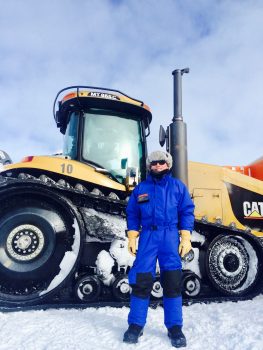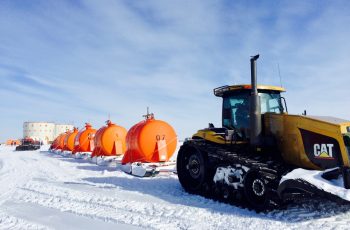Dr. Carole Dangoisse was the ESA-sponsored medical doctor spending 12 months at Concordia research station in Antarctica. She facilitated a number of experiments on the effects of isolation, light deprivation, and extreme temperatures on the human body and mind. In the following post, Carole discusses a “raid” in Antarctica.

Credit: ESA/IPEV/PNRA-C. Dangoisse
Soon enough, I discover that the arrival of each raid is a significant event for the whole station and is eagerly awaited.
A raid team is most often composed of six to eight drivers, one of whom is a doctor and is responsible for cooking the meals for everyone. The majority of the other drivers are mechanics, which ensures the team can handle maintenance of the vehicles and any urgent repairs.
The vehicles are submitted to very rough conditions, cautiously crawling on the snow track in extreme cold temperatures, whilst pulling many tons of cargo on sledges. The leading vehicle is equipped with powerful projectors worthy of a football field, whilst the last vehicle tows a snow groomer to level the track and ensure it is safe for the return voyage.
The drivers cover about 1000 km in 10 days, driving for hours on a monotonous white track, with not a tree or sign post anywhere on the horizon, the sky and ice fields often blurring into one. The track links Concordia Station on Dome C and Cap Prud’homme, the French storage and refueling station on the Antarctic coast, 5 km away from Dumont D’Urville, itself located on Petrel island.
GPS location ensures the drivers are heading in the right direction. The first 100 kilometres are the most dangerous, as the trucks must make their way through a field of crevasses. It is then a sluggish and gradual ascent from approximately sea level to the 3233 metres of the Dome C plateau.
Icy road trip
All drivers must follow a tight schedule during their Antarctic traverse. Although it is a fabulous voyage, each day is essentially filled with long hours of driving and not many distractions, apart

The caterpillar truck. Credit: ESA/IPEV/PNRA-C. Dangoisse
from music and podcasts. Some of the drivers have been doing the raid for a long time and are an inexhaustible source of entertainment.
The drivers only stay at the station for two or three days – enough time to unload the containers, reload all the waste which must go back to the coast, resupply their food and off they go, having barely rested. For their departure, we escort them with the skidoos. Once they have disappeared over the horizon, the grounds suddenly seem a little emptier and quieter.




Discussion: one comment
Amazing!